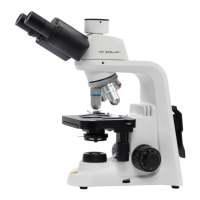2
Microscope terminology
Abbe Condenser
A two-lens sub-stage condenser
located below the stage of a
microscope and functions to
collect light and direct it onto
the object being examined. Its
high numerical aperture makes
it particularly suited for use
with most medium- and high-
magnication objectives.
Aperture, Numerical (N.A.)
The numerical aperture is an
important factor determining the
eciency of the condenser and
objective. It is represented by the
formula: (N.A. = ηsinα), where
η is the refractive index of a
medium (air, water, immersion oil
etc.) between the objective and
the specimen or condenser, and
α is half of the maximum angle
at which light enters or leaves
the lens from or to a focused
object point on the optical axis.
Cover Glass Thickness
Transmitted light objectives are
designed to image specimens
that are covered by a thin cover
glass (cover slip). The thickness
of this small glass piece is now
standardized at 0.17 mm for
most applications.
Diaphragm, Condenser
A diaphragm, which controls the
eective size of the condenser
aperture. A synonym for the
condenser illuminating aperture
diaphragm.
Magnication
The number of times by which the
size of the image exceeds the original
object. Lateral magnication is usually
meant. It is the ratio of the distance
between two points in the image
to the distance between the two
corresponding points in the object.
Micrometer (um)
A metric unit of length measurement
= 1x10
-6
meters or 0.000001 meters
Nanometer (nm)
A unit of length in the metric system
equal to 10
-9
meters.
Phase–contrast (microscopy)
A form of microscopy, which converts
dierences in object thickness and
refractive index into dierences in
image amplitude and intensity.
Real Vieweld
The diameter in millimetres of the
object eld.
Eyepiece Field of View
Real Vieweld =
Objective Magnication
For example Stellar 1:
Eyepiece eld of view = 10mm
Objective magnication = 10X
Diameter of the object eld = 18/10
= 1.8mm

